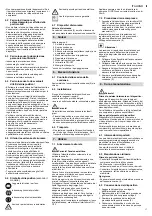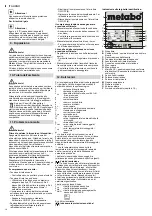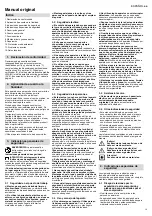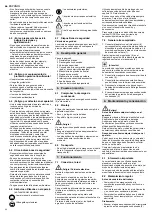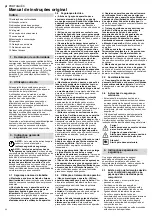
ENGLISH
en
7
Original Instructions
We, being solely responsible: Hereby declare that
these compressors, identified by type and serial
number *1), meet all relevant requirements of
directives *2) and standards *3). issuing testing
authority *4), measured LWA(M) / guaranteed
LWA(G) sound power level *5), technical
documentation for *6) - see page 4.
This tool is used for the generation of
compressed air for professional tools powered by
compressed air.
The use in the medical and food sector as well as
refilling of oxygen tanks is not permitted.
Explosive, flammable or harmful gases must not
be aspirated. Operation in potentially explosive
rooms is not permitted.
Any other use does not comply with the intended
purpose. Unspecified use, modification of the
pump or use of parts that have not been tested
and approved by the manufacturer can cause
unforeseeable damage!
Children, adolescents and untrained persons
must not use the machine and the connected
compressed air tools.
Operate the device only unter supervision.
WARNING
– Reading the operating
instructions will reduce the risk of injury.
General Safety Instructions
WARNING – Read all safety warnings and
instructions.
Failure to follow all safety
warnings and instructions may result in electric
shock, fire and/or serious injury.
Save all safety warnings and information for
future reference!
Pass on your power tool only
together with these documents. You and all other
users must be able to inform yourselves at any
time.
3.1 Work area safety
a)
Keep work area clean and well lit.
Cluttered
or dark areas invite accidents.
b)
Do not operate the device in explosive
atmospheres, such as in the presence of
flammable liquids, gases or dust.
Tools create
sparks which may ignite the dust or fumes
.
c)
Keep children and other persons away
while operating the device.
3.2 Electrical safety
a)
Tool plugs must match the outlet. Never
modify the plug in any way. Do not use any
adapter plugs with earthed (grounded) tools.
Unmodified plugs and matching outlets will reduce
risk of electric shock.
b)
Avoid body contact with earthed or
grounded surfaces, such as pipes, radiators,
ranges and refrigerators.
There is an increased
risk of electric shock if your body is earthed or
grounded.
c)
Do not expose power tools to rain or wet
conditions.
Water entering a power tool will
increase the risk of electric shock.
d)
Do not abuse the cord. Never use the cord
for carrying, hanging or unplugging the tool.
Keep cord away from heat, oil, sharp edges or
moving parts.
D
amaged or entangled cords
increase the risk of electric shock.
e)
When operating a power tool outdoors, use
an extension cord suitable for outdoor use.
Use of a cord suitable for outdoor use reduces the
risk of electric shock.
3.3 Personal safety
a)
Stay alert, watch what you are doing and
use common sense when operating a tool. Do
not use a tool while you are tired or under the
influence of drugs, alcohol or medication.
A
moment of inattention while operating power tools
may result in serious personal injury.
b)
Use personal protective equipment. Always
wear eye protection.
Protective equipment such
as a dust mask, non-skid safety shoes, hard hat or
hearing protection, depending on the type and
application of the tool, will reduce personal
injuries.
c)
Prevent unintentional starting. Ensure the
switch is in the off-position before connecting
to power source and/or battery pack, picking
up or carrying the tool.
Carrying power tools with
your finger on the switch or energising power tools
that have the switch on invites accidents.
d)
Remove any adjusting key or wrench before
turning the power tool on.
A wrench or a key left
attached to a rotating part of the power tool may
result in personal injury.
e)
Do not overreach. Keep proper footing and
balance at all times.
This enables better control
of the tool in unexpected situations.
f)
Wear appropriate clothing. Do not wear
loose clothing or jewellery. Keep your hair,
clothing and gloves away from moving parts.
Loose clothes, jewellery or long hair can be caught
in moving parts.
h)
Do not let familiarity gained from frequent
use of tools allow you to become complacent
and ignore tool safety principles.
A careless
action can cause severe injury within a fraction of a
second.
3.4 Tool use and care
a)
Do not force the power tool. Use the correct
tool for your application.
The correct tool will do
the job better and safer at the rate for which it was
designed.
b)
Do not use the tool if the switch does not
turn it on and off.
Electrical devices that can no
longer be switched on or off are dangerous and
must be repaired immediately.
c)
Disconnect the plug from the power source
and/or the battery pack from the tool before
making any adjustments, changing
accessories, or storing tools.
Such preventive
safety measures reduce the risk of starting the
power tool accidentally.
d)
Store idle tools out of the reach of children.
Do not allow persons unfamiliar with the
device or these instructions to operate the
device.
Devices are dangerous when used by
inexperienced personnel.
e)
Maintain power tools and accessories with
care. Check that the moving parts are
functioning properly and do not jam, that
there is no breakage of parts or any other
condition that may affect the device's
operation. If damaged, have the device
repaired before using.
Many accidents are
caused by poorly maintained power tools.
g)
Use the power tool, accessories, tool bits
etc. in accordance with these instructions.
Take into account the working conditions and
the work to be performed.
Use of the power tool
for operations different from those intended could
result in a hazardous situation.
h)
Keep handles and grasping surfaces dry,
clean and free from oil and grease.
Slippery
handles and grasping surfaces do not allow safe
handling and control of the tool in unexpected
situations.
3.5 Service
a)
Have your device serviced by a qualified
repair person using only genuine
replacement parts.
This will ensure that the
device functions safely.
3.6 Additional Safety Instructions
– These operating instructions are intended for
people with basic technical knowledge in
handling machines such as the one described
here. If you have had no experience with
machines of this kind, you should initially work
under the supervision of people with previous
experience.
– The manufacturer bears no liability for damage
caused by non-compliance with these operating
instructions.
Information in these operating instructions is
designated as shown below:
Danger!
Risk of personal injury or environ-
mental damage.
Risk of electric shock!
Risk of personal injury from electric
shock.
Caution!
Risk of material damage.
The following residual risks basically exist for
compressed air tools and cannot be remedied
completely even with safety installations:
4.1 Danger of injury due to escaping
compressed air and parts, which
are carried along by compressed
air!
– Never direct compressed air on people or
animals.
– Ensure that all compressed air tools and
accessories used are designed for the working
pressure or can be connected via a pressure
reducer.
– When loosening the quick coupling pay
attention that the compressed air contained in
the compressed air hose escapes suddenly.
Therefore get a firm grip of the end of the
compressed air hose to be loosened.
– Ensure that all screwed connections are always
tightened properly.
– Do not attempt to repair the pump yourself! Only
professionals may carry out repairs on
compressors, compressed containers and
compressed air tools.
4.2 Risk of personal injury and
crushing by moving parts!
– Do not operate the tool without installed guards.
– Keep in mind that the tool starts up
automatically when the minimum pressure is
reached! – Ensure the tool is disconnected from
power before servicing.
– Ensure that when switching on (e.g. after
servicing) no tools or loose parts are left on or in
the tool.
4.3 Hazard generated by insufficient
personal protection gear!
– Wear hearing protection.
– Wear protective goggles.
– Wear a breathing mask for applications
generating dust or when harmful gases, mist or
vapours are generated.
– Wear suitable work clothes.
– Wear non-slip footwear.
4.4 Hazard generated by tool defects!
– Keep tool and accessories in good repair.
Observe the maintenance instructions.
– Prior to each use check the tool for any eventual
damage: Before continuing to use the tool,
Contents
1. Declaration of Conformity
2. Specified Use
3. General Safety Instructions
4. Special Safety Instructions
Содержание Basic 160-6 W OF
Страница 2: ...2 A Bild A B Bild B C Bild C D Bild D E Bild E F G 1 2 3 7 8 9 4 5 6 2...
Страница 40: ...el 40 1 2 3 4 5 6 7 8 9 10 11 12 1 2 3 4 LWA M LWA G 5 6 4 3 1 3 2 3 3 ON OFF 3 4 3 5 Service 3 6 1 2 3...
Страница 43: ...el 43 B C D E F G H I CE J K L M N O P 10...
Страница 47: ...ru 47 1 2 3 4 5 6 7 8 9 10 11 12 1 2 3 4 LWA M LWA G 5 6 4 3 1 c 3 2 a 3 3 3 4 3 5 a 3 6 1 2 3...
Страница 51: ......
Страница 52: ...Metabowerke GmbH Metabo Allee 1 72622 Nuertingen Germany www metabo com 170 27 6820 0220...

















